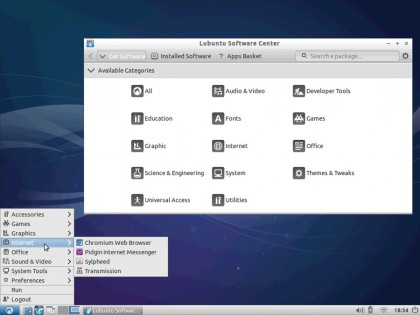Ubuntu derivatives: 5 of the best Ubuntu-based distros
Our pick of the best Ubuntu re-spins
Kubuntu - 3/5
At first glance KDE looks very much like Windows: it's got a Taskbar-like panel at the bottom of the screen, a launch menu in the corner, quicklaunch icons, and a notification area with tray icons. But to pitch KDE to new users as simply 'looking like Windows' is doing the desktop environment a disservice.
Its real power lies in the vast configuration options and features like Activities, which, sadly, users will find confusing or, at worst, totally ignore. Activities are, in fact, custom workspaces or virtual desktops that you can setup and switch between for a given activity, for example a desktop ready with all the apps open for some web development. Kubuntu is the oldest Ubuntu spin, it has an active community of users and it's the go-to distro for users burnt by Unity, but it's missing some of Ubuntu's best features, such as the Software Center.
Lubuntu - 3/5
Like KDE, Lubuntu's LXDE desktop is similar to Windows, with a panel at the bottom. The menu, though, is reminiscent of Windows 98. When you think about it, a Windows 98 look-a-like won't really lure Windows 7/XP users, especially when you consider the fact that LXDE doesn't have other Windows features, such as live thumbnail previews.
Additionally, Lubuntu lacks Ubuntu One, and integration with PCManFM and Sylpheed is still on the developers' to-do list. But then Lubuntu is aimed at a different set of users: those who want to run an Ubuntu-like desktop on an old, underpowered machine. This is something Lubuntu does remarkably well.
The fact it also supplies a pleasant desktop environment is an added bonus.
Bodhi Linux - 2/5
Another minimalist distro, Bodhi Linux is based on the elegant Enlightenment Window Manager and has its own file manager, several gadgets and compositing effects. With Bodhi you can bring an old machine back to life in style.
The distro also offers several different desktop layout styles: Desktop is a traditional layout with a menu, Taskbar and System Tray at the bottom; Laptop/Netbook puts the System Tray, menu and Taskbar on the top, along with some gadgets, and moves the application launcher to the bottom; while Fancy places the application launcher on the left of the screen. There's also a style for small/touchscreen devices, which uses an application menu like Unity's Dash or Gnome 3's Activities.
Get daily insight, inspiration and deals in your inbox
Sign up for breaking news, reviews, opinion, top tech deals, and more.
Zorin OS - 5/5
This is hands-down the best distro, offering the ultimate desktop experience for existing Linux users, as well as those coming from other operating systems. Not only is the default Zorin desktop styled to resemble Windows 7, for added familiarity, its custom application launcher also mimics the Windows 7 Start menu. Existing Linux users can use the Zorin Look Changer app to make the desktop act and look like Gnome 2.
If you can spare €10, you can download the Ultimate edition, which has additional Mac OS X and Windows 2000 styles. Zorin also includes all of the Ubuntu goodies, such as Ubuntu One, which is well integrated into the distro. It also instills good desktop practices by regularly reminding users to setup the backup app.
System requirements

Due to the different system requirements of their desktop environments, some of the spins might not run on all kinds of hardware. The most demanding distro in our roundup is Ubuntu Gnome thanks to the desktop's insistence on using accelerated graphics. On the other hand, you can run KDE, and therefore Kubuntu, on a computer that doesn't have a discrete graphics card installed. The desktop will, instead, default to having only the most basic compositing effects, but it will remain fully functional.
If you need a distro for an older box, neither Ubuntu Gnome nor Kubuntu will work as well as Lubuntu or Bodhi Linux. To productively use the LXDE-based Lubuntu you'll need at least 512MB of RAM. The project also produces special installation ISOs for computers with less than 700MB RAM.
With almost two decades of writing and reporting on Linux, Mayank Sharma would like everyone to think he’s TechRadar Pro’s expert on the topic. Of course, he’s just as interested in other computing topics, particularly cybersecurity, cloud, containers, and coding.
